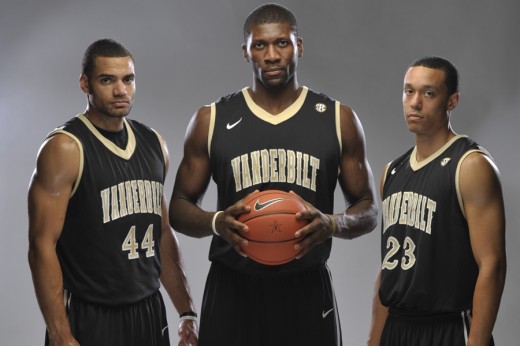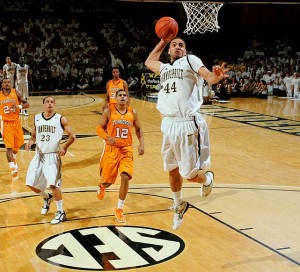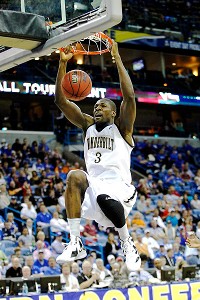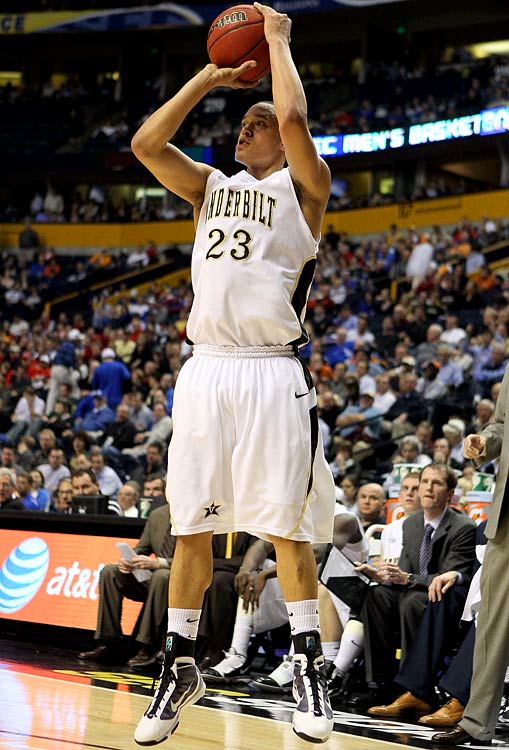Draft Profile: Jeffery Taylor, John Jenkins and Festus Ezeli
2012-05-08Today we’ll focus on three Vanderbilt Commodores that meet Cleveland’s positional needs and will be chosen around their #24, #33 and #34 picks.
John Jenkins may be this draft’s best shooter. While launching nearly nine three-pointers per game during his junior year, he knocked down 44%. He fires with his feet set, off screens, pulling up in transition or around a pick. During one game, I recall the announcers discussing his 0.6 second catch-to-release, and how that bests what is normally considered an elite time of one second. That’s his only strength though; of his 20 point per game scoring, nearly 12 of those come from deep, and his 1.2 assists, 2.9 rebounds, or 0.8 steals aren’t exactly stuffing the box score. At 6’4” and as an average athlete, he’ll only be a marginal defender against fast NBA twos.
Jeffery Taylor stands 6’7” and plays small forward. He is known as one of the draft’s elite athletes and a lock-down defender. Finishing his senior year and turning 23 this month, Taylor averaged 16 points per game, aided by 42% shooting from deep. Aside from his shooting, he is most effective in transition. Defensively he moves very well and clocks-in for every possession. His rebounding is mediocre and shot creation marginal; his role in the NBA is basically as a 3-and-D guy. Currently projected to go off the board around #20, the Cavs likely need to package two picks if they want Taylor.
Festus Ezeli is a senior from Nigeria, a legitimate center at a long-armed 6’11” and 255 pounds, with outstanding athleticism for a man that size. Offensively, his repertoire lacks. Most of his “post moves” amount to sealing his man off, and dunking. Not that there’s anything wrong with that; his 10 points in 23 minutes per game come on 54% from the field and he attempts nearly as many free throws as field goals. He effectively muscles up on post defense and blocked two shots per game. Like a lot of young, athletic big men, his rebounding on the offensive end far outpaces his prowess on the defensive boards. Maybe it’s reasonable to shrug off 18-year-old Andre Drummond grabbing 16% of available defensive rebounds, but Ezeli isn’t much better at three years his elder. Ezeli tries to block too many shots, frequently leaving him out of position. As a final note, in 3000 career minutes, Ezeli dished out 18 assists. Due to his unrefined post footwork and occasional oven-mitt hands, he turned the ball over that many times in one five game stretch this season.
For more details, onto some game recaps:
NCAA tourney against Wisconsin: In Vandy’s NCAA tournament loss against Wisconsin, Taylor finished with 9 points, 1 rebound, 0 assists, 1 steal and 3 turnovers in 30 minutes…kind of uninspiring. Operating primarily from the perimeter on offense; nine of his twelve shots were jumpers, of which he only connected on three. Despite not posing a huge threat penetrating to the basket, he showed off really well-practiced footwork and crossover moves to launch into pull-up jumpers, once leaving his man crumpled on the ground as he rose up for an uncontested 18 footer. He defended Wisconsin’s point guard capably on multiple possessions and understands his rotational responsibilities, even swatting a three-point attempt on one close-out.
Jenkins netted 13 points on 42% True Shooting, along with 2 rebounds and 2 assists. Of his 13 field goal attempts and 6 free throws, all but two were jumpers. He was able to find shots, off screens or step-backs & pull-ups, either out of isolation or a pick-and-roll. In this game, they weren’t going in. His defense was largely non-noteworthy; a non-attempted box-out allowed a put-back and his man sped by him en route to an and-one.
After beginning the game on the bench due to a non-disclosed discipline issue, Ezeli posted one of his season’s best games, with 14 points on 73% True Shooting and 11 rebounds. His offense is not terribly nuanced; of his five field goals, twice he established deep position, received a pass & dunked and twice he scored on offensive rebounds. In his three attempts at making post moves – he charged, travelled, and bobbled a pass, resulting in a blocked shot. This was a really impressive game though. Playing very physically, he drew four off-the-ball fouls battling underneath. As the ball swings around Vandy’s perimeter offense, he effectively seals his man off to benefit from an easy dunk. Defensively, he hedged well & rotated back on a pick-and-roll, and he closed out on a shooter with choppy steps. In the post, he denied the ball well, including stealing an inlet pass, and he generally made it difficult for Badger big men to get shots off.
SEC tourney against Ole Miss: In 28 minutes, Taylor turned in the most invisible effort I’ve watched while profiling draft picks: 2 points on 1 of 5 shooting, 2 rebounds, 2 assists, 0 steals, 0 blocks, 0 turnovers and 1 foul. The Commodores won easily though, and JT rotated and slid his feet well on defense, drawing two offensive fouls.
Jenkins again functioned primarily as a jump shooter, with 13 of his 16 shots coming from behind the arc. He made five from deep and finished with 23 points on 62% true shooting. This is subjective, but JJ gets fouled while jump shooting more than any player I’ve seen. The announcers noted his ownership of the SEC record for career four-point plays. Again, his non-shooting offense was limited, including one transition layup getting chased-down and one time tripping and losing the ball. It’s pretty simple, shooting is what he does.
Ezeli battled foul trouble and finished with 0 points in only 16 minutes. He did not foul out of this game, but has been consistently plagued by the issue, fouling out five times in 2011 – 2012. His physicality works both ways though, as he drew two more fouls battling for deep position. He exhibited a wide range of defensive skills; rotating as help to block a layup, and forcing tough looks whether faced up against or backed down by a big man, or switching onto the ball handler in a pick-and-roll. His rebounding was a mixed bag; poor box-out fundamentals resulted in three defensive rebounds, but his aggressive demeanor at the other end netted him four off the offensive glass. Finally, bad hands resulted in a bobbled pass and negated an opportunity for a dunk.
Summary: Watching these two games shows some of the danger in watching a couple of games and drawing conclusions. Taylor averaged 16 & 5 this year, but only 5.5 and 1.5 in the games discussed above. Jenkins drained 45% of his nearly 300 threes in the games I didn’t watch, but only 32% in the two profiled. Ezeli is occassionally noted as a player that struggles with team defense, but these two games were solid. Also his 8 defensive rebounds against Wisconsin matched his second highest total of the last two years.
Taylor’s projected role in the NBA as a “3-and-D” player is fairly straightforward; if he can’t consistently drain open looks or impede the opponent’s best, his usefulness will be limited. Although it is a skill where he has improved every year, prior to this season, he only connected on 30% from downtown. It may be worthwhile to look closely at his athleticism and shooting performance at the combine, and also see if any “Harrison Barnes and Terrence Ross couldn’t score against him in workouts” stories start coming out. If they both pan out, Taylor and Alonzo Gee would be duplicative. If sufficient scoring is added through the lottery and free agency though, that’s not a horrible thing.
I think Jenkins can provide valuable bench offense to an NBA team, and Cleveland can certainly use more offense. With a shot that fast and accurate, for 18 minutes a night, he can run around screens, pop jumpers, and help maintain a lead while the starters hit the pine.
If the Cavs snagged Ezeli with a 2nd round pick; I could dig it. I think he’ll be a suitable backup center; a Brendan Haywood to someone’s Tyson Chandler. He possesses appropriate size and athleticism, plays aggressively and flashes defensive skill. In my “2011 Draft Follow-Up” from last week, I noted the strength of LaVoy Allen’s sophomore and junior years and that was perhaps indicative of his rookie year success. Ezeli could fit this mold. Despite a small usage decrease this year, his offensive rating plummeted. In similar minutes, his scoring, rebounding and shot blocking were down, while his fouls and turnovers were up. He missed the first ten games of his senior year due to a secondary NCAA violation and a knee sprain; perhaps these issues de-railed a potentially excellent senior year.





Ryan Young,
Thanks for the compliment?
I’m not sure if you like the post, you think it’s laughable, or you’re insinuating that you possess the power to read Chris Grant’s mind.
I don’t disagree with your Chris-Grant-mind-read (other than I think you mean Jeremy Lamb), so I am unsure why he is laughing at me. I agree that Davis should be top priority, followed by wing scoring / athleticism, then size.
Nice article Kevin. I think any of this trio is a possibility with the second/third pick we have. If Chris Grant reads all I this I bet he just laughs. I think he has a much clearer view of what needs to be done… Something like this. We need scoring. It should come from our two holes in the starting lineup – SG and SF. If we dot get Davis, we take the best player at either of those spots, and use our next pick on the best player at the other. If we fall to 5th, maybe that is… Read more »
John,
may 30.
When is the draft lottery?
Kevin,
Glad someone finally mentioned Green. I would actually like if the Cavs drafted 1 or 2 of these seniors/tweeners with our 2nd rounders.
At that point, I’d rather take a chance on a proven guy with less upside than waste a pick on a project – see Christian Eyenga over Dejuan Blair & Sam Young. Guys like Green, Crowder, DJ Odom, Tu Holloway might fit the bill.
yes hoopsdogg, its completely silly to project how college players will turn out in the NBA. I would much rather pay gee 5 million this year than trade him for the first overall pick, anthony davis. No way some good college prospect should ever be considered a better value than some obscure d-leaguer who came out of no where to have a solid 2 months in a weird condensed season before slowly fading into a below average player down the stretch, no matter how much cheaper that player would be. Is it a risk hoopsdogg? Obviously. But to say you… Read more »
As for the Taylor/Gee debate. You can’t compare a rookie who’s never played in the NBA to someone who has. It just doesn’t work. There’s no guarantee he’ll be any good, and shooting 42% from three in college does not mean he’ll shoot better than 33% in the pros. The numbers don’t necessarily translate. As always, the devil you know is better than the devil you don’t, and as many have said, you can never have too many athletic wings who can score and play defense (unlike last year, when we had ONE).
Sounds like a gamble, but watching White in the tournament, it’s obvious the kid can PLAY. He could definitely be a good combo forward, and there’s not much he can’t do on a basketball court. His condition seems like a lot to overcome, and the Cavs have already been through something similar with Delonte. In the second round I’d take a gamble on him, but I wouldn’t do it without making sure I had an infrastructure in place to support him, and without fully committing to him for at least two years. To take a kid like that and then… Read more »
Here’s the article on Royce White’s generalized anxiety disorder. I don’t know anything about the disorder, but he is working hard to overcome it.
http://espn.go.com/mens-college-basketball/story/_/id/7505656/iowa-state-royce-white-battle-college-basketball
Regarding Moe Harkless; I watched a St. John’s game yesterday. Other than his poor shooting, he reminds me of Jeremy Lamb. Harkless’ style is so laid-back, it doesn’t always look like he’s playing very hard. Some would call it smooth or effortless. I’m still undecided on whether this is a good thing or a bad thing.
Scuzz,
I hope that whatever team drafts Royce White helps him get the proper care for his “generalized anxiety disorder”. From what I’ve read, it’s a pretty obstructive part of his life. ESPN had a long article on him.
There are players I would rather that Cleveland take, potentially Draymond Green as a similarly skilled passing PF.
I agree that 4 mil/yr isn’t overpaying Gee, but anything more might be.
As far as Taylor is concerned, the “3 & D” projection reminds me of Bruce Bowen. I think you can always use a guy like that. I get your point about drafting a SF with different skills though. I wouldn’t be upset if they pick Harkless or Miller.
Speaking of SF, what would everyone think about Royce White? On talent alone, he seems like a top 10 pick. But his anxiety about flying is obviously an issue. Is he too risky?
Kyle, good question. I think if we end up paying Gee $4 mil per year, that’s not really overpaying him. That’s just my opinion, but we paid Boobie $4.5 mil last year, Parker $2.25 mil, and Hollins $2.5 mil, so I’m using those numbers as some reference. So I would prefer we resign Gee even though it would cost about $2.8 million per year extra. We have so many holes on this team that I’d like the team to be able to address replacing guys like Semih Erden, Manny Harris, Luke Harangody, and Anthony Parker before we start to find… Read more »
Based on what I know today, I wouldn’t trade up to get Taylor, but I don’t think that having Taylor and Gee on the team is a bad thing. Both could play 20 – 25 minutes a night. Their total salaries for the next few years would probably be $6 million-ish. The Cavs just need to find offense from the other wing and a big man (in addition to Kyrie).
I agree with AlexS though, that when it’s all said and done, there will probably be players available that I prefer over Taylor.
Alex, why would you want to overpay Gee when you can draft a guy who’s better and younger, plus cheaper? I think for those reasons a guy like Taylor would be an excellent choice with one of the later picks. Since it looks like we’ll have to overpay Gee to keep him, drafting someone who could fill the same role for dirt cheap and who probably has more upside seems like a no-brainer if that’s the best player available at that spot. And a PG-SG combo could work wonderfully, I think that we would need some help in the frontcourt… Read more »
But I would prefer a SF with a different skill set rather than a guy in Taylor who is basically a marginally better and younger version of Gee. Someone like Harkless or Q Miller would be a good option because they have higher upsides than Taylor and offer something new at the SF position.
I like Taylor, I just don’t know if he would be a head-and-shoulders improvement over what we have now.
@Jimbo
Dumars and Thomas
Rondo and Allen
Payton and Allen
Westbrook and Harden
Hardaway and Richmond
Magic and Scott (different because Magic is unique)
Etc.
Obviously you still need defensive oriented big guys, but I think there are plenty of examples of successful teams that featured 2 great guards.
Parker & Ginobili, Rondo & Allen?
There has been a lot of hype around a potential Beal and Irving backcourt. Historically though, can anyone remember a strong PG-SG combo in the NBA? Do not seem to be complementary positions…
HoopsDogg,
I’m shooting for a pretty ambitious schedule of profiles. Each of the players you mention is on my radar. We’ll see how much content I actually publish between now and June 28th. Glad to hear you’re enjoying them.
“If we resign Gee, having Taylor would be redundant.”
Perhaps, but Taylor shot 42% from 3 pt. range and Gee only shot 32%. If the Cavs draft Bradley Beal with their first pick, drafting Taylor would make sense. Beal and Irving would give the Cavs two guards that could shoot, drive, and create for others. That would fit nicely with one player hanging out at the 3 pt line (Taylor), and two players looking for a put back or an offensive rebound (TT, Varejao).
Thanks for the profiles! I find John Jenkins to be a pretty decent specialist candidate, with just enough height to play 2 Guard. I’d love to see him as a floor stretcher for the Cavs. The other two guys don’t seem like anything special, unless Jenkins becomes a lockdown defender, but he’s going to have to really work on his offensive game. Similar Guys I’d like to see profiles on, who might be there on our last three pics: Jae Crowder from Marquette, who’s a Gerald Wallace/Ron Artest/Mbah Moute type, who finishes well around the basket and seems to have… Read more »
Ezeli reminds me of a Brendan Haywood or Kendrick Perkins. As long as we have good scoring from the forward positions, I’d be happy with him defending the paint. Jenkins would be nice to take with a 2nd round pick. I don’t really see much of a difference with Doron Lamb, who’s projected to go significantly higher than Jenkins. We need a 2nd unit scorer who can spread the floor for Irving to penetrate, and we could use him in a Kyle Korver-type role. If we resign Gee, having Taylor would be redundant. I’d rather that pick be spent on… Read more »